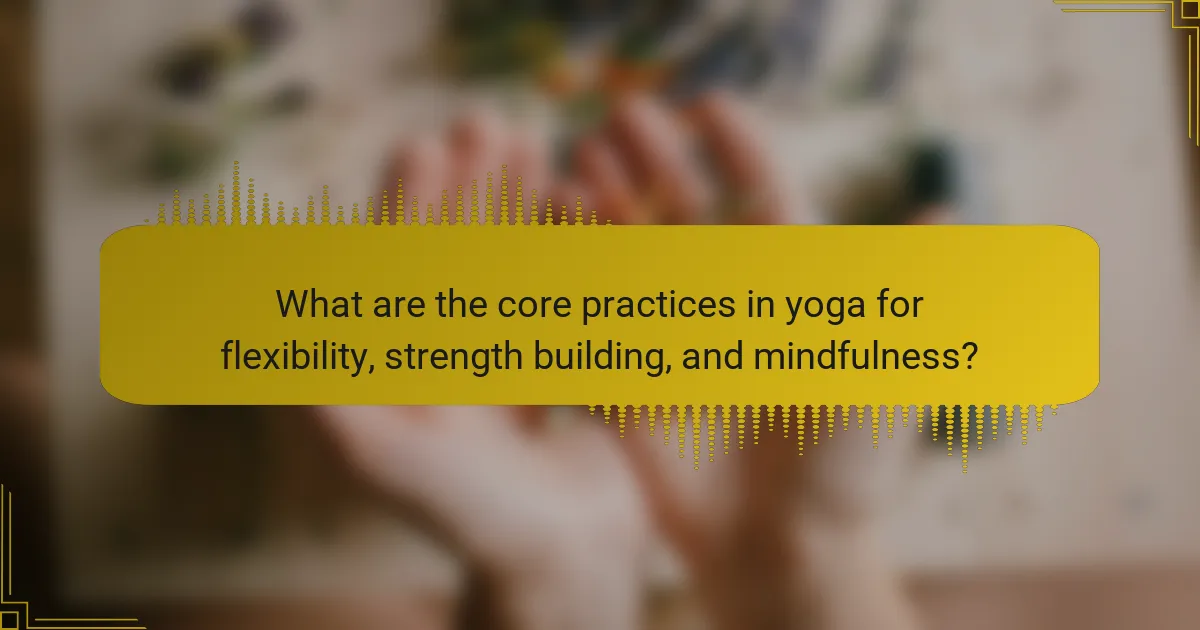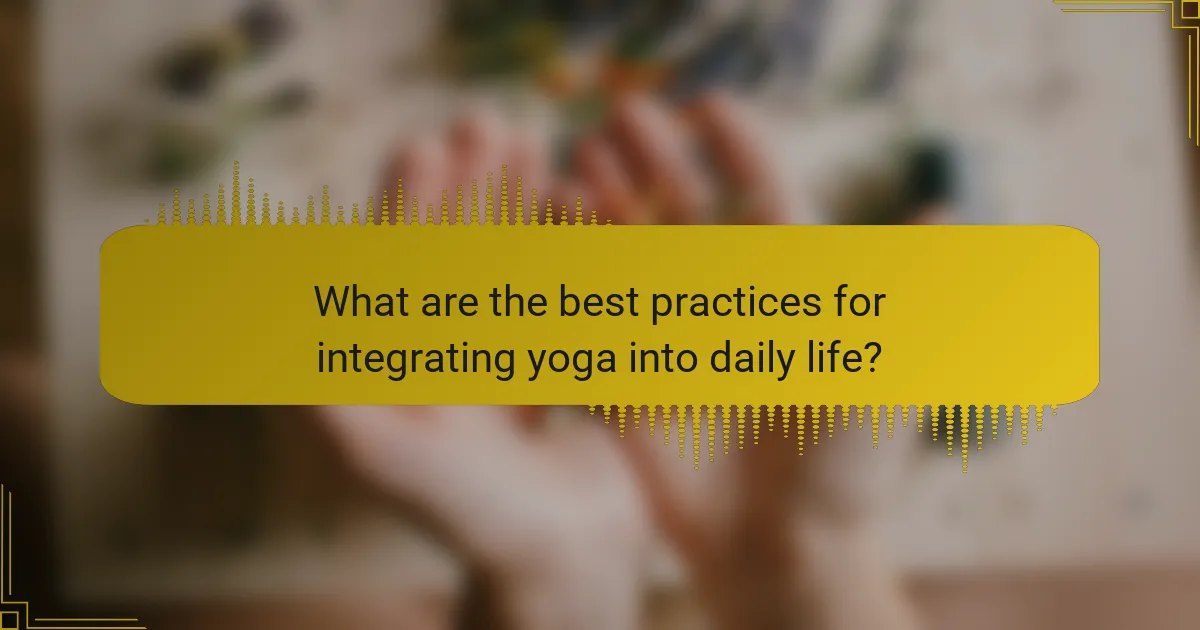Yoga practices enhance flexibility, build strength, and promote mindfulness. Key components include asanas like Downward Dog and Warrior poses, pranayama techniques for breath control, and mindfulness meditation for stress reduction. Regular practice can lead to significant improvements in physical and mental resilience, fostering overall well-being. Establishing a consistent routine and incorporating various styles will maximize these benefits.

What are the core practices in yoga for flexibility, strength building, and mindfulness?
Core practices in yoga for flexibility, strength building, and mindfulness include asanas, pranayama, and meditation. These practices enhance physical flexibility, build muscle strength, and cultivate mental awareness.
Asanas such as Downward Dog and Warrior poses improve flexibility and strength. Pranayama techniques like Ujjayi breathing enhance lung capacity and focus. Mindfulness meditation fosters present-moment awareness, reducing stress and improving overall well-being.
Incorporating these practices regularly can lead to increased physical and mental resilience. For instance, a study found that consistent yoga practice improves flexibility by 20% over three months.
Combining these elements creates a holistic approach to wellness, addressing both body and mind effectively.
How does yoga improve flexibility?
Yoga significantly enhances flexibility through a combination of stretching, strength building, and mindful breathing. Regular practice targets muscle groups, allowing them to lengthen and relax, which improves overall range of motion. For example, poses like Downward Dog and Cobra stretch various muscle groups, promoting greater flexibility over time. As a result, practitioners often experience reduced tension and enhanced mobility in daily activities.
What specific poses enhance flexibility?
Certain yoga poses significantly enhance flexibility. These poses include Downward Dog, Forward Bend, Pigeon Pose, and Butterfly Pose. Each pose targets different muscle groups, promoting overall flexibility. For instance, Pigeon Pose stretches the hip flexors, while Forward Bend lengthens the hamstrings and spine. Regular practice can lead to improved range of motion and reduced muscle tension.
What is the role of breath in increasing flexibility?
Breath plays a crucial role in increasing flexibility during yoga practices by enhancing oxygen flow to muscles and promoting relaxation. Proper breathing techniques, such as diaphragmatic breathing, help release tension and facilitate deeper stretches. This process allows practitioners to achieve greater range of motion and improve overall flexibility. Additionally, mindful breathing fosters a connection between body and mind, reinforcing the benefits of each pose. As a result, breathwork becomes a foundational aspect of yoga that supports flexibility, strength building, and mindfulness.
In what ways does yoga contribute to strength building?
Yoga enhances strength building through various practices that engage multiple muscle groups. It develops core stability, improves balance, and increases overall body awareness. Poses like Plank and Warrior strengthen specific muscles while promoting endurance. Additionally, yoga fosters mental resilience, which supports physical strength. Regular practice can lead to improved muscle tone and functional strength, beneficial for daily activities.
Which yoga styles are most effective for building strength?
Hatha, Vinyasa, and Ashtanga yoga styles are most effective for building strength. Hatha focuses on foundational postures, enhancing muscular endurance. Vinyasa incorporates dynamic movements, promoting strength through flow. Ashtanga offers a rigorous sequence, significantly increasing muscle power and stamina. Each style varies in intensity and approach, catering to different strength-building needs.
How can yoga be integrated with strength training?
Integrating yoga with strength training enhances overall fitness and promotes balance. Combining yoga poses with strength exercises improves flexibility, core stability, and mental focus. For example, incorporating poses like Warrior II and Downward Dog can enhance muscle engagement during weightlifting. This synergy fosters a holistic approach to physical fitness, allowing for greater endurance and recovery. Additionally, practicing mindfulness through yoga can lead to improved concentration and motivation during strength workouts.
What mindfulness techniques are incorporated in yoga practices?
Yoga practices incorporate mindfulness techniques such as breath awareness, body scanning, and meditation. These techniques enhance present-moment awareness and foster a deeper connection between mind and body. Breath awareness involves focusing on inhalation and exhalation, promoting relaxation and concentration. Body scanning encourages practitioners to notice sensations throughout their body, enhancing bodily awareness. Meditation, often integrated into yoga sessions, cultivates mental clarity and emotional balance. Together, these techniques contribute to improved flexibility, strength, and overall well-being in yoga.
How does mindfulness in yoga differ from other mindfulness practices?
Mindfulness in yoga focuses on integrating breath with movement, promoting a deeper connection to the body. In contrast, other mindfulness practices may emphasize mental awareness or meditation without physical engagement. The unique attribute of yoga is its combination of physical postures and mindful breathing, enhancing both flexibility and mental clarity. This holistic approach fosters a distinct experience compared to traditional mindfulness techniques.
What are the unique attributes of yoga practices for specific demographics?
Yoga practices uniquely cater to various demographics by addressing specific needs and preferences. For seniors, gentle styles like Hatha enhance flexibility and balance. Athletes benefit from power yoga, which builds strength and endurance. Children engage with playful yoga, fostering mindfulness and coordination. Pregnant individuals practice prenatal yoga to support physical changes and reduce stress. Each demographic experiences tailored benefits that enhance their overall well-being.
How do yoga practices vary for athletes?
Yoga practices for athletes vary significantly based on their specific needs for flexibility, strength, and mindfulness. Athletes often focus on dynamic stretches to enhance flexibility, building strength through poses like Warrior and Downward Dog, and incorporating mindfulness techniques to improve focus and reduce stress.
Flexibility-focused sessions may include poses that target specific muscle groups used in their sport, while strength-building practices often integrate resistance elements. Mindfulness practices, such as breath control and meditation, help athletes enhance mental clarity and resilience.
Each athlete’s routine can be tailored to their unique requirements, ensuring optimal performance and recovery. This customization highlights the root attribute of yoga: its adaptability to individual needs.
What adaptations are beneficial for seniors in yoga?
Yoga adaptations for seniors enhance flexibility, strength, and mindfulness. Modifications include using props, chair yoga, and gentle poses. These adaptations accommodate physical limitations and promote safety. For example, using blocks can help with balance and support. Chair yoga provides a stable option, allowing seniors to participate without strain. Gentle poses like cat-cow or seated forward bends improve mobility while reducing injury risk. Regular practice fosters mental clarity and emotional well-being, making yoga a holistic approach for seniors.
What rare benefits can be gained from advanced yoga practices?
Advanced yoga practices offer rare benefits such as enhanced proprioception, which improves body awareness and spatial orientation. These practices also promote neuroplasticity, allowing the brain to adapt and reorganize itself, leading to improved mental resilience. Additionally, advanced techniques can facilitate deep meditative states that enhance emotional regulation and stress management. Lastly, some practitioners experience unique physical adaptations, such as increased joint mobility and strength, which are not typically achieved through standard yoga routines.
How can yoga influence mental clarity and focus?
Yoga enhances mental clarity and focus through mindfulness techniques and breath control. Practicing yoga regularly can reduce stress, which often clouds thinking. Meditation, a key component of yoga, sharpens concentration by training the mind to remain present. Additionally, specific poses improve blood circulation to the brain, promoting cognitive function. Studies have shown that consistent yoga practice can lead to improved attention span and mental resilience.
What unique experiences do practitioners report from long-term yoga practice?
Practitioners of long-term yoga report unique experiences such as enhanced physical flexibility, increased mental clarity, and improved emotional resilience. They often experience a deeper connection to their bodies, fostering greater self-awareness. Additionally, many note a significant reduction in stress levels and an overall sense of well-being. Long-term practitioners may also develop a unique ability to remain present in the moment, which enhances their mindfulness in daily life.

What are the best practices for integrating yoga into daily life?
To effectively integrate yoga into daily life, establish a consistent routine that incorporates flexibility, strength building, and mindfulness. Start with short sessions, gradually increasing duration and complexity.
1. Set a specific time each day for practice, creating a habit.
2. Choose a comfortable space free from distractions.
3. Incorporate various yoga styles to enhance physical and mental benefits.
4. Use online resources or classes to maintain motivation and guidance.
5. Reflect on your progress regularly to stay engaged and adjust goals.
By following these practices, you can seamlessly blend yoga into your daily routine, improving overall well-being.
How can beginners start their yoga journey effectively?
Beginners can start their yoga journey effectively by focusing on foundational practices that enhance flexibility, strength, and mindfulness. Begin with basic poses like Downward Dog and Child’s Pose to improve flexibility. Incorporate strength-building poses such as Plank and Warrior I to develop physical strength. Mindfulness can be cultivated through breath awareness and meditation techniques. Consistency in practice is key; aim for short sessions several times a week to build a sustainable routine. Consider joining a beginner class for guided instruction and community support.
What common mistakes should practitioners avoid in yoga?
Practitioners should avoid common mistakes like neglecting proper alignment, pushing beyond their limits, and skipping warm-ups. These errors can lead to injuries and hinder progress. Focusing on breath control and being mindful of personal boundaries enhances flexibility, strength, and mindfulness.
What expert insights can enhance yoga practices for flexibility, strength, and mindfulness?
Expert insights for enhancing yoga practices focus on integrating specific techniques that improve flexibility, strength, and mindfulness. Incorporating dynamic stretches before sessions enhances flexibility by preparing muscles. Strength-building can be achieved through poses like Warrior II and Plank, which engage multiple muscle groups. Mindfulness is fostered by breath awareness and meditation, allowing practitioners to connect deeply with their bodies. Regular practice of these techniques can lead to significant improvements in overall yoga performance and personal well-being.